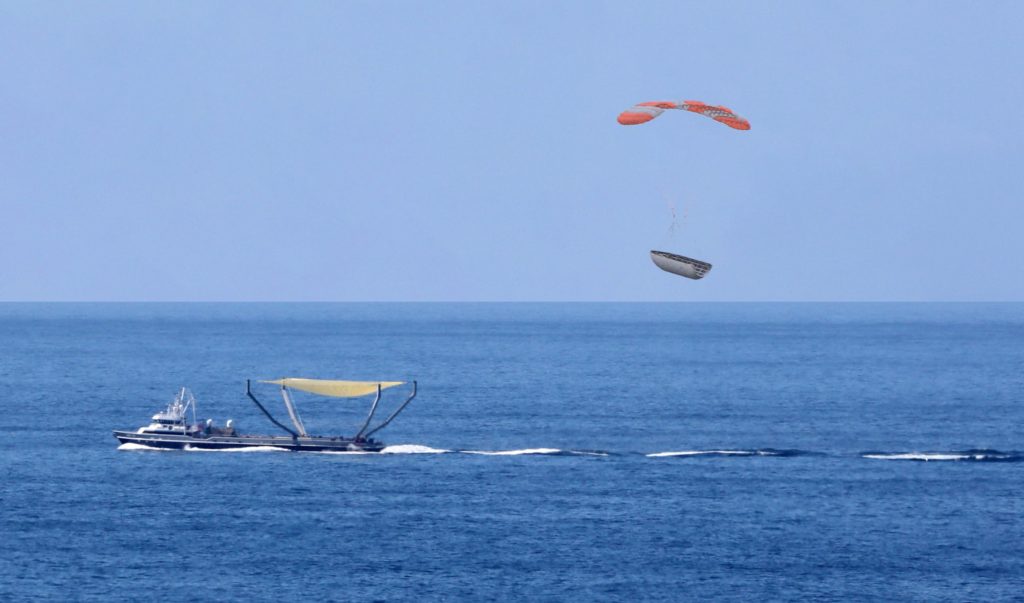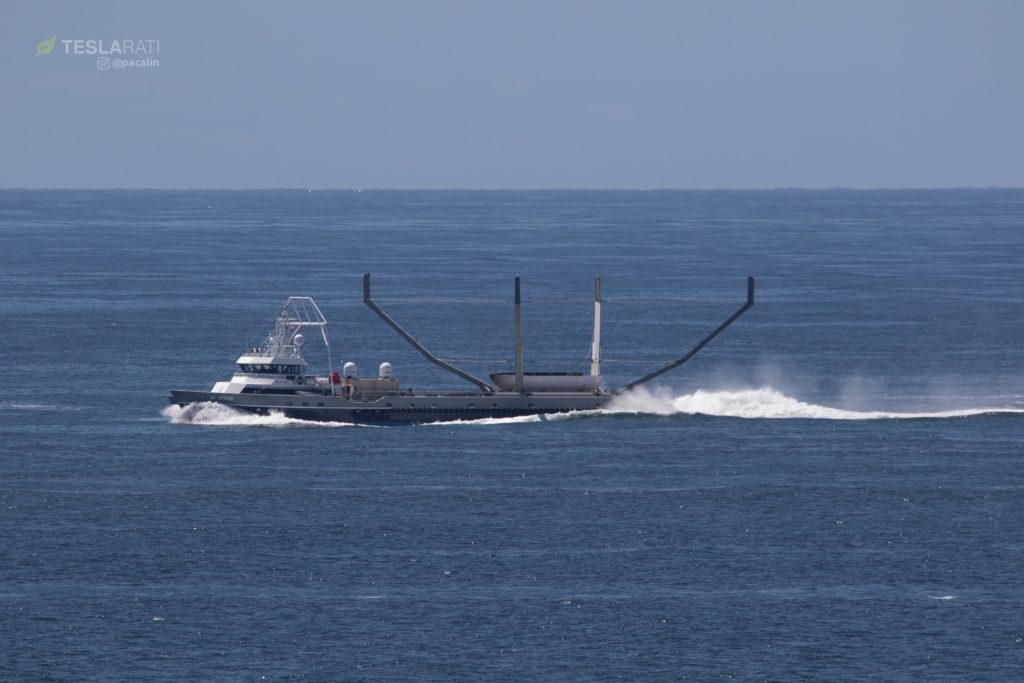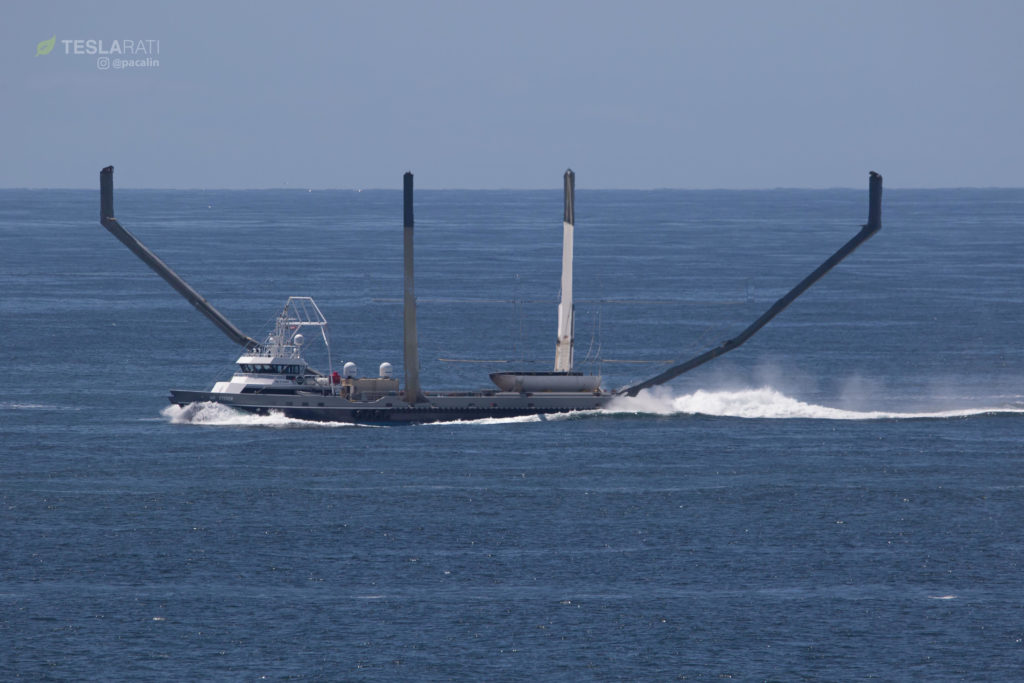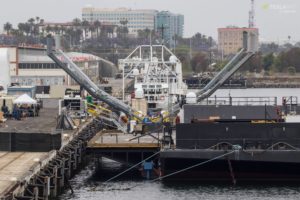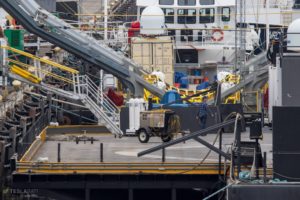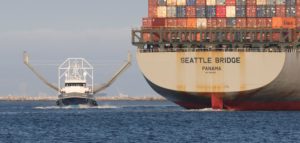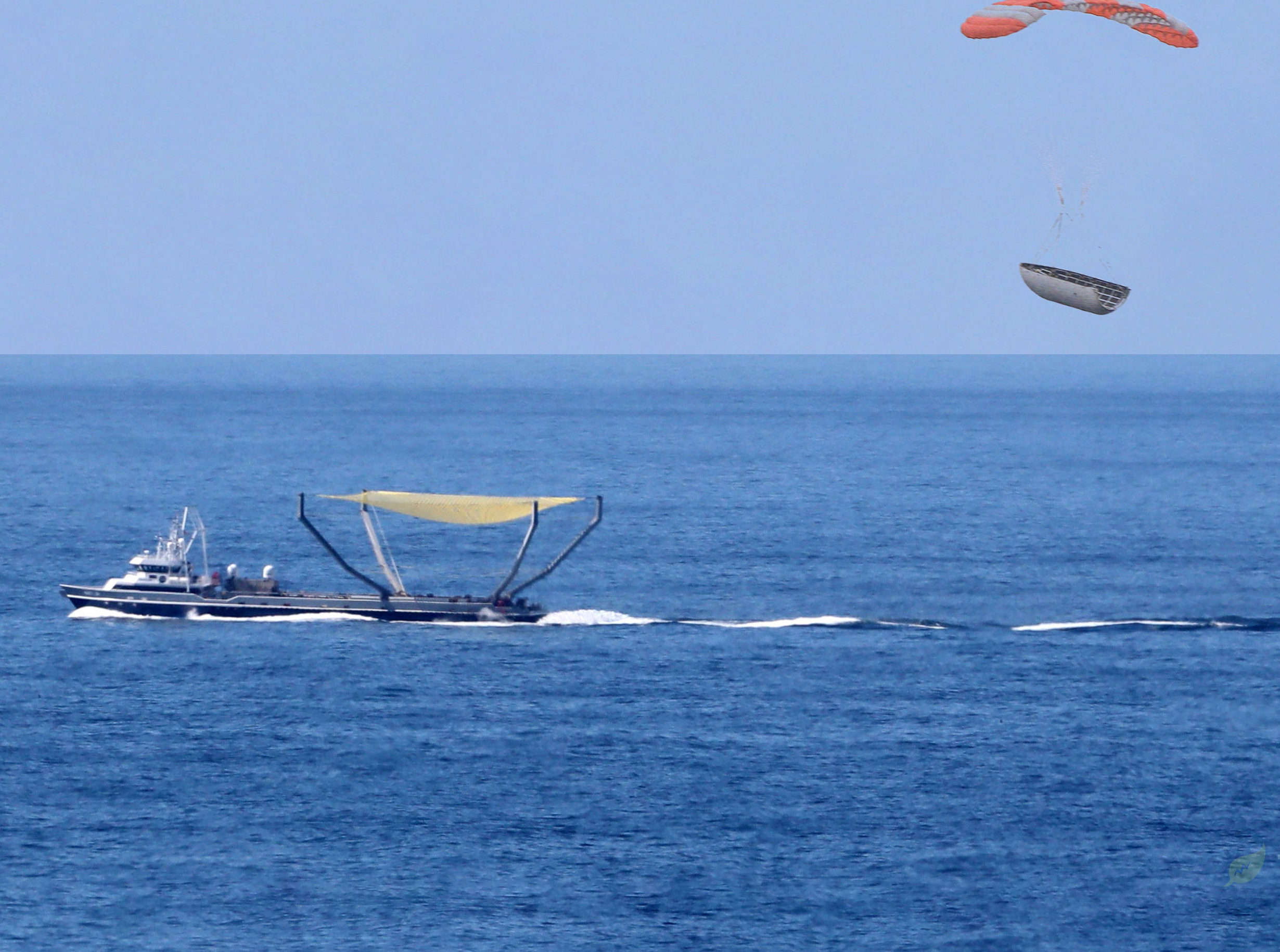
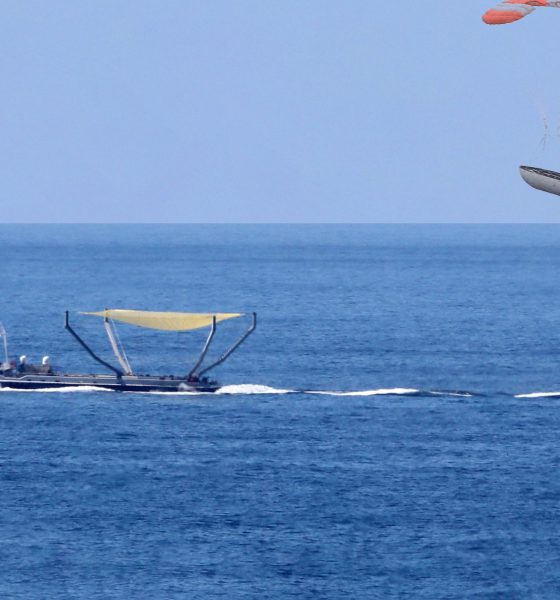
News
SpaceX’s first fairing catch imminent with plans to 4X Mr Steven’s net
Following SpaceX CEO Elon Musk’s brief confirmation that the launch company would be quadrupling recovery vessel Mr Steven’s already-huge net, members of the /r/SpaceX subreddit created a rough visualization of what that expanded net might look like once completed.
Based on rough estimates done by the author, SpaceX’s official confirmation that fairings had landed within 50 meters of Mr Steven’s net indicates that the parasailing halves are able to somewhat reliably reach Mr Steven’s net with a margin of error of roughly 0.01% when they really need 0.005% to be caught in the vessel’s net every time. Based on specifications from the vessel’s shipyard, his current claws appear to be roughly 75% the length of the entire vessel, or something like 40m long by 30 to 40m wide.
- An artist rendering of a Falcon 9 fairing parasailing towards Mr Steven’s net. Original photos by Chuck Bennett (Instagram @chuckbennett) and SpaceX. (/Chuck Bennet/SpaceX/Eric Ralph)
- It’s difficult to imagine how Mr Steven’s already vast net could plausibly be expanded by a factor of two in each dimension. I certainly can’t wait to see how SpaceX engineers and technicians tackle the task. (Pauline Acalin)
- Created by Reddit /u/Pipinpadiloxacopolis, this visualization shows Mr Steven with net with 4X the area currently installed. (Teslarati/ /u/Pipinpadiloxacopolis)
Several days after the author’s speculation was published, Mr. Musk appeared to effectively corroborate it by stating on Twitter that Mr Steven’s net would have its area expanded fourfold in order to operationalize fairing recovery: to quadruple the area, both the length and the width of the net would need to be expanded by a factor of two (square) or perhaps 50% width-wise and 150% lengthwise (more rectangular). Mr Steven’s massive steel arms appear to be fairly permanent in their current forms, suggesting that changing the aspect ratio of the net would be far more effort than simply expanding his arms along their current paths. Either way, lengthwise growth of a factor of 2-2.5 would appear to functionally close the gap on that 0.005% margin of error (the current 0.01% – missing by 50 meters – divided by 2 equals 0.005%) required, albeit by modifying the recovery vessel instead of optimizing the fairings’ hardware and software.
TL;DR: @SpaceX's fairing recovery engineers/techs have achieved a margin of error of like 0.01% when they actually need ~0.005% to reliably catch fairings in Mr Steven's net. Success is imminent 😀 https://t.co/MfPdzdBkyO
— Eric Ralph (@13ericralph31) June 1, 2018
Put more simply, a net with four times the area would roughly halve the accuracy required from each fairing half for reliable recovery. Compared with the original (left) above, Reddit user Pipinpadiloxacopolis followed Musk’s rough estimation and did a rough Photoshop (right) of the fairing recovery vessel’s current arms, expanding it by 2X in each direction to arrive at a quadrupled area. Although I would argue that Mr Steven’s forward arms are unlikely to ever move beyond their current end-point around 10 meters behind the vessel’s crew cabin and cockpit, /u/Pipin’s estimate is probably a decent prediction for the upgraded vessel’s most likely appearance.
What’s less clear is whether the depth of the net will increase alongside the length and width, nor whether the already massive arms will have to rely on some sort of retraction/pivot mechanism to allow Mr Steven to safely maneuver within Port of Los Angeles waters. Regardless of the solution that SpaceX expertise arrives at, the already eclectic recovery vessel is all but guaranteed to look even more absurd and awesome than it already does. With any luck, the net expansion may allow SpaceX to finally achieve their first successful ‘catch’ of a Falcon fairing, ending the need for mass-storage of unreusable fairing halves grabbed off of the ocean surface.
- Mr Steven and drone ship Just Read The Instructions captured at their berths on June 5th. JRTI also appears to be preparing for a return to action with Iridium-7. (Pauline Acalin)
- Even SpaceXers deserve a break. (Pauline Acalin)
- Mr Steven slips between massive container ship canyons on the final leg of its return. (Chuck Bennett, Instagram @chuckbennett)
Stay tuned, as Teslarati photographer Pauline Acalin will be tracking modifications made to Mr Steven closely over the next several weeks. As of now, the vessel will return to the Pacific Ocean for another fairing catch attempt sometime in the second or third week of July. We’ll find out soon whether Musk’s mentioned upgrades can be realized before then.

News
Tesla Cybercab tests are going on overdrive with production-ready units
Tesla is ramping its real-world tests of the Cybercab, with multiple sightings of the vehicle being reported across social media this week.

Tesla is ramping its real-world tests of the Cybercab, with multiple sightings of the autonomous two-seater being reported across social media this week. Based on videos of the vehicle that have been shared online, it appears that Cybercab tests are underway across multiple states.
Recent Cybercab sightings
Reports of Cybercab tests have ramped this week, with a vehicle that looked like a production-ready prototype being spotted at Apple’s Visitor Center in California. The vehicle in this sighting was interesting as it was equipped with a steering wheel. The vehicle also featured some changes to the design of its brake lights.
The Cybercab was also filmed testing at the Fremont factory’s test track, which also seemed to involve a vehicle that looked production-ready. This also seemed to be the case for a Cybercab that was spotted in Austin, Texas, which happened to be undergoing real-world tests. Overall, these sightings suggest that Cybercab testing is fully underway, and the vehicle is really moving towards production.
Production design all but finalized?
Recently, a near-production-ready Cybercab was showcased at Tesla’s Santana Row showroom in San Jose. The vehicle was equipped with frameless windows, dual windshield wipers, powered butterfly door struts, an extended front splitter, an updated lightbar, new wheel covers, and a license plate bracket. Interior updates include redesigned dash/door panels, refined seats with center cupholders, updated carpet, and what appeared to be improved legroom.
There seems to be a pretty good chance that the Cybercab’s design has been all but finalized, at least considering Elon Musk’s comments at the 2025 Annual Shareholder Meeting. During the event, Musk confirmed that the vehicle will enter production around April 2026, and its production targets will be quite ambitious.
News
Tesla gets a win in Sweden as union withdraws potentially “illegal” blockade
As per recent reports, the Vision union’s planned anti-Tesla action might have been illegal.

Swedish union Vision has withdrawn its sympathy blockade against Tesla’s planned service center and showroom in Kalmar. As per recent reports, the Vision union’s planned anti-Tesla action might have been illegal.
Vision’s decision to pull the blockade
Vision announced the blockade in early December, stating that it was targeting the administrative handling of Tesla’s facility permits in Kalmar municipality. The sympathy measure was expected to start Monday, but was formally withdrawn via documents sent to the Mediation Institute and Kalmar Municipality last week.
As noted in a Daggers Arbete report, plans for the strike were ultimately pulled after employer group SKR highlighted potential illegality under the Public Employment Act. Vision stressed its continued backing for the Swedish labor model, though Deputy negotiation manager Oskar Pettersson explained that the Vision union and IF Metall made the decision to cancel the planned strike together.
“We will not continue to challenge the regulations,” Petterson said. “The objection was of a technical nature. We made the assessment together with IF Metall that we were not in a position to challenge the legal assessment of whether we could take this particular action against Tesla. Therefore, we chose to revoke the notice itself.”
The SKR’s warning
Petterson also stated that SKR’s technical objection to the Vision union’s planned anti-Tesla strike framed the protest as an unauthorized act. “It was a legal assessment of the situation. Both for us and for IF Metall, it is important to be clear that we stand for the Swedish model. But we should not continue to challenge the regulations and risk getting judgments that lead nowhere in the application of the regulations,” he said.
Vision ultimately canceled its planned blockade against Tesla on December 9. With Vision’s withdrawal, few obstacles remain for Tesla’s long-planned Kalmar site. A foreign electrical firm completed work this fall, and Tesla’s Careers page currently lists a full-time service manager position based there, signaling an imminent opening.
News
Tesla Semi program Director teases major improvements
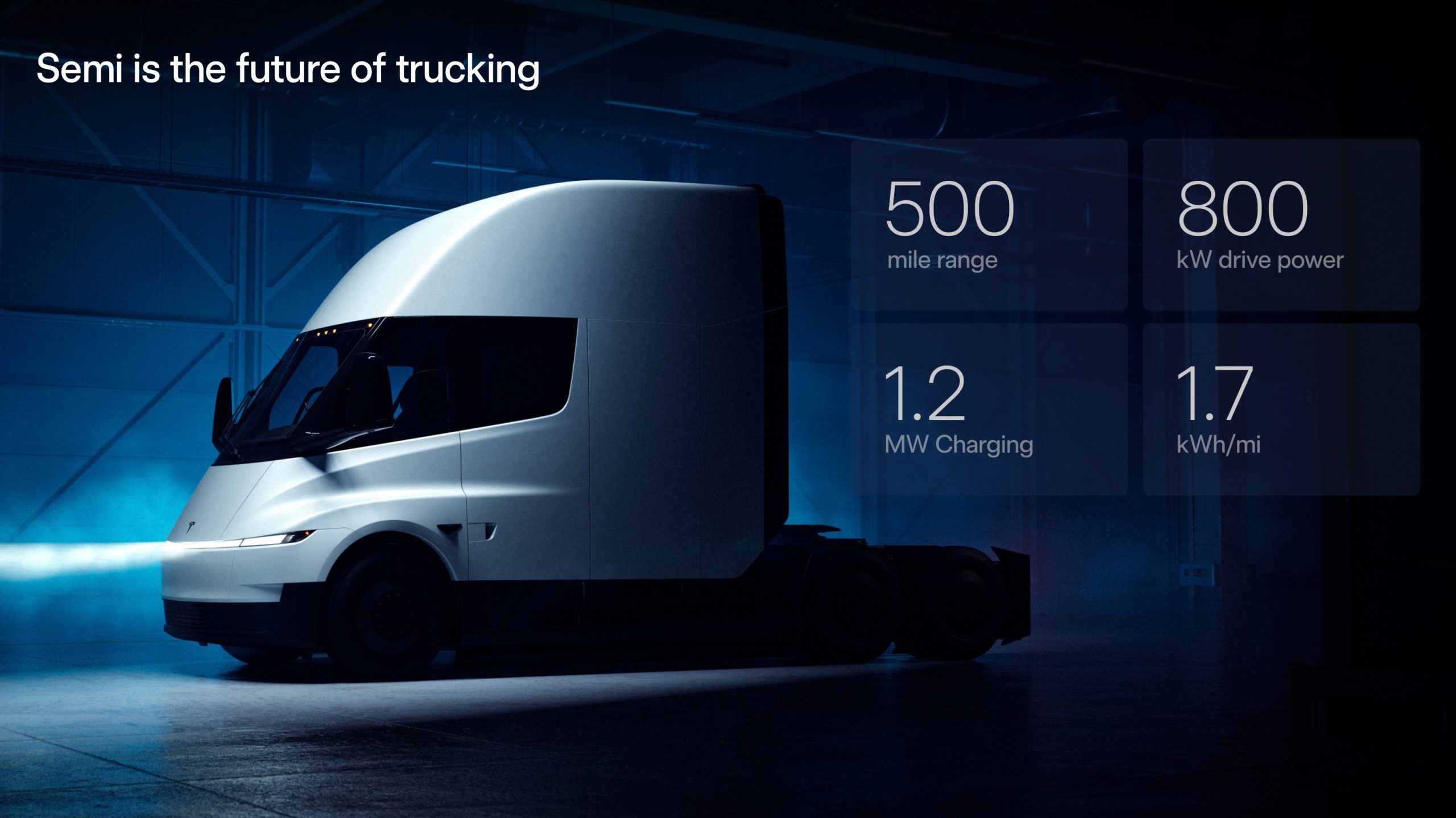
Tesla Semi Program Director Dan Priestly teased the major improvements to the all-electric Class 8 truck on Thursday night, following the company’s decision to overhaul the design earlier this year.
Priestley said he drove the Semi on Thursday, and the improvements appear to be welcomed by one of the minds behind the project. “Our customers are going to love it,” he concluded.
Just drove the redesigned Semi. Our customers are going to love it. https://t.co/KZ88sf1CDL
— Dan Priestley (@danWpriestley) December 19, 2025
The small detail does not seem like much, but it is coming from someone who has been involved in the development of the truck from A to Z. Priestley has been involved in the Semi program since November 2015 and has slowly worked his way through the ranks, and currently stands as the Director of the program.
Tesla Semi undergoes major redesign as dedicated factory preps for deliveries
Tesla made some major changes to the Semi design as it announced at the 2025 Annual Shareholder Meeting that it changed the look and design to welcome improvements in efficiency.
Initially, Tesla adopted the blade-like light bar for the Semi, similar to the one that is present on the Model Y Premium and the Cybertruck.
Additionally, there are some slight aesthetic changes to help with efficiency, including a redesigned bumper with improved aero channels, a smaller wraparound windshield, and a smoother roofline for better aero performance.
All of these changes came as the company’s Semi Factory, which is located on Gigafactory Nevada’s property, was finishing up construction in preparation for initial production phases, as Tesla is planning to ramp up manufacturing next year. CEO Elon Musk has said the Semi has attracted “ridiculous demand.”
The Semi has already gathered many large companies that have signed up to buy units, including Frito-Lay and PepsiCo., which have been helping Tesla test the vehicle in a pilot program to test range, efficiency, and other important metrics that will be a major selling point.
Tesla will be the Semi’s first user, though, and the truck will help solve some of the company’s logistics needs in the coming years.
